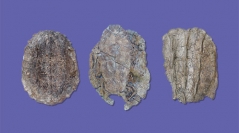

 Comptes Rendus Palevol
22 (34) - Pages 689-709
Comptes Rendus Palevol
22 (34) - Pages 689-709Matamata turtles (Chelus Duméril, 1806) are composed of two extant species, Chelus fimbriata Schneider, 1783 and Chelus orinocensis Vargas-Ramírez, Caballero, Morales-Betancourt, Lasso, Amaya, Martínez, Silva-Viana, Vogt, Farias, Hrbek, Campbell & Fritz, 2020, inhabitants of the main freshwater drainages of northern South America. The systematics and palaeobiogeography of Chelus is still unresolved. Here, we describe several new fossil specimens from the Late Miocene of Urumaco (Venezuela) and Tatacoa (Colombia). The fossils are mostly complete, articulated shells that allow reestablishing validity of two extinct taxa, Chelus colombiana Wood, 1976 and Chelus lewisi Wood, 1976. One of the specimens of C. lewisi from Urumaco represents the first record within the genus for which autopodial bones (a left manus) and additional limb bones are preserved together with ashell, demonstrating evolutionary conservatism in limb anatomy for the genus. The specimen comes from the Socorro Formation, representing the earliest so far known record of Chelus for the Urumaco sequence. Additionally, one specimen from Tatacoa is the first fossil for which cervical and pectoral girdle elements are preserved. Phylogenetic analysis supports the existence of two separate clades inside of Chelus, one formed by the extinct species and the other by the extant ones.
Testudines, South America, Chelidae, Matamata, Miocene fossils